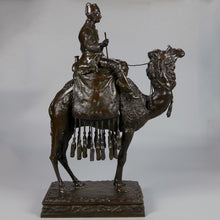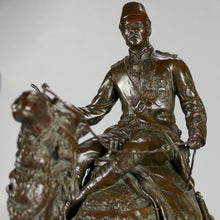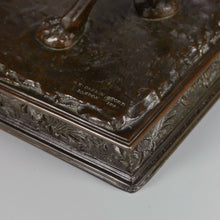Gordon of Khartoum Mounted on a Camel, 1892
Adding product to your cart
Height: 59cm (23in) x 43cm (17in) x 17.8cm (7in)
Patinated bronze. Major-General Charles George Gordon CB (1833-1885) mounted on a Soudan camel, in full dress uniform of an Egyptian general. Signed and dated: ‘E Onslow Ford 1892’ to the naturalistic base. The sides of the base modelled with title plaque, palms and scrolls inscribed ‘Soochow / GORDON / Ta-it-san // Equatorial Africa / Khartoum / Sebastopol // Kah-ding / Singpoo / Mauritius / Pekin / Fu-shan // Gindokoro / Chan-Chu-Fu / Nankin’. The foot inscribed ‘Published by Arthur Leslie Collie 39b Old Bond Street London January the 6th 1892’
In the wake of the Fall of Khartoum and Gordon’s murder in 1885, the Corps of Royal Engineers, which Gordon joined as a second lieutenant in 1852, commissioned their own statue of the emblematic hero to stand outside School of Military Engineering at Chatham. The commission was entrusted to Edward Onslow Ford RA, whose full-size plaster model was exhibited to great acclaim in the Central Hall of the Royal Academy in May 1890.
Read more
The present bronze belongs to an edition designed for domestic settings produced by the Bond Street art dealer Arthur Leslie Collie (fl.1834-1905). The idea of portraying Gordon on his camel was Onslow-Ford’s idea, rather than the Royal Engineers, and was no doubt intended to distinguish it from Sir William Hamo Thornycroft’s statue in Victoria Embankment Gardens, London (also produced in reduced scale by Collie). Gordon was proud of his camel-riding skills, and once explained that he owed 'his position among the people in the Soudan to these’. Once Ford's design was accepted, it was immediately agreed that the statue should show General Gordon wearing his British, French and Ottoman decorations and in the uniform of an Egyptian General, reflecting the fact Gordon had spent six years as Governor of the Equatorial Provinces of Egypt, attempting destroy the flourishing East African slave-trade in the face of every type of obstacle.
Following the Re-Conquest of the Sudan (1896-98) by Anglo-Egyptian forces under General Kitchener, a second full-size bronze was cast in 1899 for the newly built Governor General's Palace at Khartoum. After temporary display in central London, this second version was shipped to Africa in 1904. En route it survived the sinking of two of its transporting vessels, the Cedarden which sunk in the Thames and the SS Lesbian which was submerged in the Nile. On Sudan’s independence in 1956, the Onslow Ford’s Khartoum statue was moved again, this time to the memorial school established in Gordon’s name in England where it remains.
The Pall Mall Gazette praised Onslow Ford’s design as 'not only ornamental, unique, and appropriate, but most suggestive of life ... especially in the the minor details that included the historical rattan cane seen in Gordon’s right hand. This of course was Gordon’s weapon of choice when in 1863 at the request of the Chinese government he took command of the small ill-disciplined Chun Chen Chun (aka the Ever-Victorious Army) with which he took Taitsan, Quinsan, Soochow and destroyed the power of the Wangs. Onslow Ford's attention to detail further extended to the authentic Sudanese waterbottle and Gordon’s mount, with the contemporary press reporting that he worked for two consecutive summers at Regent’s Park Zoo on a small wax model of 'a highly bred Soudan camel, ‘such a one as was used by officers of the Camel Corps’.

Edward Onslow Ford RA (1852-1901) received his artistic training in Antwerp and Munich where he married a fellow art student who was the daughter of a Bavarian baron. Much of Ford's early sculptural success came with heads or busts. These included portraits of notable fellow artists John Everett Millais, Sir Lawrence Alma-Tadema and Sir Hubert von Herkomer. These were considered extremely refined and showing his subjects at their best. They led to him receiving a number of commissions for public monuments and statues, both in Britain and overseas. Ford also produced bronze statuettes of free-standing figures loosely drawn from mythology or of allegorical subjects, characteristic of the New Sculpture movement, of which he was a leading exponent.

He worked closely with Sir Alfred Gilbert RA who had a neighbouring studio in Fulham, and together they worked on a number of experimental techniques, notably in lost wax casting which Ford used throughout his career. Like other New Sculpture artists, Ford was actively involved in the production of reduced scale versions of his work. Ford’s first public commission in 1881 was for the statue of Rowland Hill now at King Edward Street in London. Other notable commissions included Irving as Hamlet (1883); the Shelley Memorial at University College, Oxford (1892); the standing statue of William Ewart Gladstone (1894) which, somewhat ironically as the prime minister who failed to extract Gordon from Khartoum, is regarded as one of Ford's best portrait works.




















